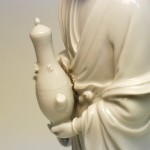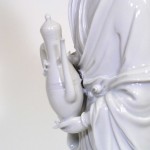This Blanc de Chine figure likely depicts the Taoist immortal, Magu. She is often shown as a beautiful young woman, adorned with flowers, holding a ewer containing the elixir of life in hands with long, delicate fingernails, and is accompanied by a deer, a symbol of immortality. Similar items, also known as Dehua porcelain, were created as early as the Ming Dynasty (1368-1644). This example, however, likely dates from the Qing Dynasty (1644-1912). The clear glaze over the white porcelain can create a wonderful sense of depth and detail within the deep folds and incised decoration.
The delicate fingers, horns, handle, and spout were broken and in some cases missing entirely. We were able to reassemble the remaining pieces and sculpt what was missing. We invisibly restored the damaged areas, paying great attention to matching both the color and the translucency of the glaze. Restoration was minimized to cover as little of the surface as possible while making the object whole again and reestablishing its original beauty.








